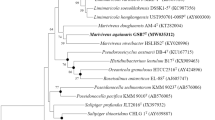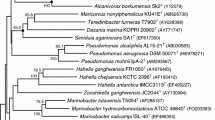Abstract
A Gram-stain-negative strictly aerobic, short-rod-shaped, and non-motile bacterial strain designated HSLHS9T was isolated from surface seawater collected from the South China Sea. Strain HSLHS9T could grow at 15–41°C (optimum 28°C), at pH 5.0–9.0 (optimum 6.0–7.0), and in 0–7% (w/v) NaCl (optimum 2–3%). Phylogenetic analysis based on 16S rRNA gene sequences indicated that strain HSLHS9T shared high identities with the closely related Parahaliea aestuarii S2-26T (98.6%) and Parahaliea mediterranea 7SM29T (97.8%) and formed a distinct lineage within the genus Parahaliea. Wholegenome sequencing of strain HSLHS9T revealed the size of 4.8 Mbp and DNA G + C content of 61.8 mol%. Strain HSLHS9T shared the digital DNA-DNA hybridization values of 22.4% and 23.0%, and the average nucleotide identities of 79.7% and 79.9%, respectively, with the two type strains above. The predominant cellular fatty acids of the strain were summed feature 8 (C18:1ω6c and/or C18:1ω7c), summed feature 3 (C16:1ω7c and/or C16:1ω6c), C17:1ω8c, and C16:0. The sole isoprenoid quinone was identified as Q-8. The polar lipids were phosphatidylglycerol, diphosphatidylglycerol, phosphatidylethanolamine, aminolipid, and two glycolipids. Based on taxonomic data obtained in this study, it is suggested that strain HSLHS9T represents a novel species of the genus Parahaliea, for which the name Parahaliea maris sp. nov. is proposed. The type strain is HSLHS9T (= MCCC 1A06717T = KCTC 52307T). An emended description of the genus Parahaliea is also provided.
Similar content being viewed by others
References
Auch, A.F., von Jan, M., Klenk, H.P., and Göker, M. 2010. Digital DNA-DNA hybridization for microbial species delineation by means of genome-to-genome sequence comparison. Stand. Genomic Sci.2, 117–134.
Bankevich, A., Nurk, S., Antipov, D., Gurevich, A.A., Dvorkin, M., Kulikov, A.S., Lesin, V.M., Nikolenko, S.I., Pham, S., Prjibelski, A.D., et al. 2012. SPAdes: a new genome assembly algorithm and its applications to single-cell sequencing. J. Comput. Biol.19, 455–477.
Chang, Y.Q., Meng, X., Du, Z.Z., and Du, Z.J. 2019. Kineobactrum sediminis gen. nov., sp. nov., isolated from marine sediment. Int. J. Syst. Evol. Microbiol.69, 2395–2400.
Collins, M.D., Pirouz, T., Goodfellow, M., and Minnikin, D.E. 1977. Distribution of menaquinones in actinomycetes and corynebacteria. J. Gen. Microbiol.100, 221–230.
Csotonyi, J.T., Stackebrandt, E., Swiderski, J., Schumann, P., and Yurkov, V. 2011. Chromocurvus halotolerans gen. nov., sp. nov., a gammaproteobacterial obligately aerobic anoxygenic phototroph, isolated from a Canadian hypersaline spring. Arch. Microbiol.193, 573–582.
Czelusniak, J., Goodman, M., Moncrief, N.D., and Kehoe, S.M. 1990. Maximum parsimony approach to construction of evolutionary trees from aligned homologous sequences. Methods Enzymol.183, 601–615.
Euzéby, J. 2009. List of new names and new combinations previously effectively, but not validly, published. Int. J. Syst. Evol. Microbiol.59, 1555–1556.
Euzéby, J. 2012. List of new names and new combinations previously effectively, but not validly, published. Int. J. Syst. Evol. Microbiol.62, 1017–1019.
Felsenstein, J. 1981. Evolutionary trees from DNA sequences: A maximum likelihood approach. J. Mol. Evol.17, 368–376.
Felsenstein, J. 1985. Confidence limits on phylogenies: an approach using the bootstrap. Evolution39, 783–791.
Garrity, G.M., Bell, J.A., and Lilburn, T. 2015. Gammaproteobacteria class. nov. In Whitman, W.B. and John Wiley and Sons, Inc., Bergey’s Manual of Systematics of Archaea and Bacteria, Bergey’s Manual Trust.
Jung, H.S., Jeong, S.E., Kim, K.H., and Jeon, C.O. 2017. Parahaliea aestuarii sp. nov., isolated from the Asan Bay estuary. Int. J. Syst. Evol. Microbiol.67, 1431–1435.
Konkit, M., Kim, J.H., and Kim, W. 2016. Marimicrobium arenosum gen. nov., sp. nov., a moderately halophilic bacterium isolated from sea sand. Int. J. Syst. Evol. Microbiol.66, 856–861.
Kumar, S., Stecher, G., Li, M., Knyaz, C., and Tamura, K. 2018. MEGA X: molecular evolutionary genetics analysis across computing platforms. Mol. Biol. Evol.35, 1547–1549.
Lai, Q., Liu, Y., Yuan, J., Du, J., Wang, L., Sun, F., and Shao, Z. 2014. Multilocus sequence analysis for assessment of phylogenetic diversity and biogeography in Thalassospira bacteria from diverse marine environments. PLoS One9, e106353.
Lin, C.Y., Zhang, X.Y., Liu, A., Liu, C., Song, X.Y., Su, H.N., Qin, Q.L., Xie, B.B., Zhang, Y.Z., and Chen, X.L. 2015. Haliea atlantica sp. nov., isolated from seawater, transfer of Haliea mediterranea to Parahaliea gen. nov. as Parahaliea mediterranea comb. nov. and emended description of the genus Haliea. Int. J. Syst. Evol. Microbiol.65, 3413–3418.
Minnikin, D.E., O’Donnell, A.G., Goodfellow, M., Alderson, G., Athalye, M., Schaal, A., and Parlett, J.H. 1984. An integrated procedure for the extraction of bacterial isoprenoid quinones and polar lipids. J. Microbiol. Methods2, 233–241.
Oren, A. and Garrity, G.M. 2013. List of new names and new combinations previously effectively, but not validly, published. Int. J. Syst. Evol. Microbiol.63, 3131–3134.
Oren, A. and Garrity, G.M. 2015. List of new names and new combinations previously effectively, but not validly, published. Int. J. Syst. Evol. Microbiol.65, 2017–2025.
Park, S., Yoshizawa, S., Inomata, K., Kogure, K., and Yokota, A. 2012. Halioglobus japonicus gen. nov., sp. nov. and Halioglobus pacificus sp. nov., members of the class Gammaproteobacteria isolated from seawater. Int. J. Syst. Evol. Microbiol.62, 1784–1789.
Parks, D.H., Imelfort, M., Skennerton, C.T., Hugenholtz, P., and Tyson, G.W. 2015. CheckM: assessing the quality of microbial genomes recovered from isolates, single cells, and metagenomes. Genome Res.25, 1043–1055.
Richter, M. and Rosselló-Móra, R. 2009. Shifting the genomic gold standard for the prokaryotic species definition. Proc. Natl. Acad. Sci. USA106, 19126–19131.
Saitou, N. and Nei, M. 1987. The neighbor-joining method: a new method for reconstructing phylogenetic trees. Mol. Biol. Evol.4, 406–425.
Sasser, M. 1990. Identification of bacteria by gas chromatography of cellular fatty acids. MIDI Technical Note 101. MIDI Inc.
Shi, R., Xu, S., Qi, Z., Zhu, Q., Huang, H., and Weber, F. 2019. Influence of suspended mariculture on vertical distribution profiles of bacteria in sediment from Daya Bay, Southern China. Mar. Pollut. Bull.146, 816–826.
Spring, S., Lunsdorf, H., Fuchs, B.M., and Tindall, B.J. 2009. The photosynthetic apparatus and its regulation in the aerobic gammaproteobacterium Congregibacter litoralis gen. nov., sp. nov. PLoS One4, e4866.
Spring, S., Riedel, T., Spröer, C., Yan, S., Harder, J., and Fuchs, B.M. 2013. Taxonomy and evolution of bacteriochlorophyll a-containing members of the OM60/NOR5 clade of marine gammaproteobacteria: description of Luminiphilus syltensis gen. nov., sp. nov., reclassification of Haliea rubra as Pseudohaliea rubra gen. nov., comb. nov., and emendation of Chromatocurvus halotolerans. BMC Microbiol.13, 118.
Spring S., Scheuner, C., Göker, M., and Klenk, H.P. 2015. A taxonomic framework for emerging groups of ecologically important marine gammaproteobacteria based on the reconstruction of evolutionary relationships using genome-scale data. Front. Microbiol.6, 281.
Urios, L., Intertaglia, L., Lesongeur, F., and Lebaron, P. 2008. Haliea salexigens gen. nov., sp. nov., a member of the Gammaproteobacteria from the Mediterranean Sea. Int. J. Syst. Evol. Microbiol.58, 1233–1237.
Vashist, P., Nogi, Y., Ghadi, S.C., Verma, P., and Shouche, Y.S. 2013. Microbulbifer mangrovi sp. nov., a polysaccharide-degrading bacterium isolated from an Indian mangrove. Int. J. Syst. Evol. Microbiol.63, 2532–2537.
Wattam, A.R., Abraham, D., Dalay, O., Disz, T.L., Driscoll, T., Gabbard, J.L., Gillespie, J.J., Gough, R., Hix, D., Kenyon, R., et al. 2014. PATRIC, the bacterial bioinformatics database and analysis resource. Nucleic Acids Res.42, D581–D591.
Wayne, L.G., Brenner, D.J., Colwell, R.R., Grimont, P.A.D., Kandler, O., Krichevsky, M.I., Moore, L.H., Moore, W.E.C., Murray, R.G.E., Stackebrandt, E., et al. 1987. Report of the Ad Hoc committee on reconciliation of approaches to bacterial systematics. Int. J. Syst. Bacteriol.37, 463–464.
Weisburg, W.G., Barns, S.M., Pelletier, D.A., and Lane, D.J. 1991. 16S ribosomal DNA amplification for phylogenetic study. J. Bacteriol.173, 697–703.
Williams, K.P., Gillespie, J.J., Sobral, B.W.S., Nordberg, E.K., Snyder, E.E., Shallom, J.M., and Dickerman, A.W. 2010. Phylogeny of gammaproteobacteria. J. Bacteriol.192, 2305–2314.
Yoon, S.H., Ha, S.M., Kwon, S., Lim, J., Kim, Y., Seo, H., and Chun, J. 2017a. Introducing EzBioCloud: a taxonomically united database of 16S rRNA gene sequences and whole-genome assemblies. Int. J. Syst. Evol. Microbiol.67, 1613–1617.
Yoon, S.H., Ha, S.M., Lim, J., Kwon, S., and Chun, J. 2017b. A large-scale evaluation of algorithms to calculate average nucleotide identity. Antonie van Leeuwenhoek110, 1281–1286.
Acknowledgments
This work was jointly supported by the GDAS’ Project of Science and Technology Development [2019GDASYL-0401002], the Guangdong Province Science and Technology Innovation Strategy Special Fund [2018B020205003] and the Science and Technology Plan Project of Guangdong Province [2019B-030316017].
Author information
Authors and Affiliations
Corresponding authors
Additional information
Conflicts of Interest
The authors declare that there is no conflict of interest.
Supplemental material for this article may be found at http://www.springerlink.com/content/120956.
Electronic Supplementary Material
Rights and permissions
About this article
Cite this article
Liu, Y., Du, J., Zhang, J. et al. Parahaliea maris sp. nov., isolated from surface seawater and emended description of the genus Parahaliea. J Microbiol. 58, 92–98 (2020). https://doi.org/10.1007/s12275-020-9405-z
Received:
Revised:
Accepted:
Published:
Issue Date:
DOI: https://doi.org/10.1007/s12275-020-9405-z




